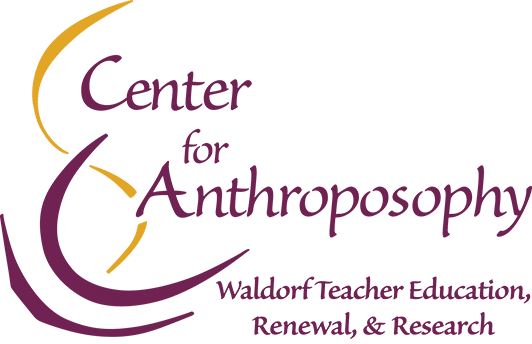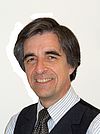 What is it like to meditate while wearing headphones?
What is it like to meditate while wearing headphones?
This question is prompted by the story I recently read of a Black Hawk pilot who practices meditation on the battlefields of Iraq. Contemplative meditation, which he learned at West Point from a visiting professor of poetry, may be antithetical to the ethos of the war zone, he admits, even though it helps steady his composure in the face of death and suffering. He describes how he masks his meditation by sitting on his cot wearing headphones. His barrack buddies assume he is listening to music, “which is cool” –– but his headphones are turned off. In fact he is practicing “being in the moment”.
This story appears in The Heart of Education: A Call to Renewal –– Transforming the Academy through Collegial Conversations by Arthur Zajonc, professor of physics at Amherst College, and the best selling author Parker Palmer (reviewed below). It makes clear that meditation is acceptable in certain contexts but by no means in all. Soldiers––or indeed any government employees––need not fear for their reputation if they are observed listening privately to electronic music, or indeed using any form of electronic media to calm their nerves or relax the mind. The same cannot be said if they are known to practice meditation, however privately. While public prayer is allowed––even required, for instance, in moments of national sorrow––the private practice of contemplative meditation may expose public servants to suspicion, perhaps even to loss of credibility.
In a Waldorf community, the case may well be reversed. A teacher’s reputation will only be enhanced by an active meditative life, though few will openly talk about it. But woe betide the Waldorf teacher who is caught sitting in the school parking lot or relaxing in the faculty room with headphones on!
What does this juxtaposition tell us about the way we perceive one another? It points to the pervasive and often semi-conscious perception of context.
In Waldorf schools––as also in the approach to scientific enquiry advanced by Arthur Zajonc in his new book––we try to cultivate not only the capacity to see but the ability to see the way we see: that is, to become aware of the cognitive framework or context in which we place our perceptions as we assess, weigh, and, yes, judge them.
“All seeing is seeing-as.” In this issue of our newsletter Center & Periphery, we offer you some examples of coming to consciousness of the “as” in our seeing, especially through the artistic media of eurythmy and film, as well as through changing approaches to higher education and our understanding of the brain’s plasticity.
Read on and read-as!
Douglas Gerwin, Director
Center for Anthroposophy
In this Issue
Dateline Wilton, NH: A Physicist’s Perspective on Eurythmy
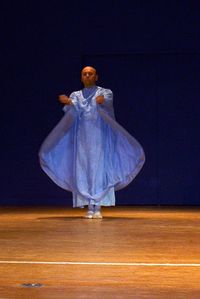 After a eurythmy workshop at the Northeast Regional AWSNA Conference at High Mowing School in November 2010, Donald Griswold, physics teacher in the Lake Champlain Waldorf High School, got into conversation with Barbara Richardson, the Center’s Coordinator of Foundation Studies and a practicing eurythmist. At Barbara’s prompting, Donald offered some written reflections on his experience.
After a eurythmy workshop at the Northeast Regional AWSNA Conference at High Mowing School in November 2010, Donald Griswold, physics teacher in the Lake Champlain Waldorf High School, got into conversation with Barbara Richardson, the Center’s Coordinator of Foundation Studies and a practicing eurythmist. At Barbara’s prompting, Donald offered some written reflections on his experience.
What did I see that helped me understand what eurythmy is about?
I am a physicist and see the world made up of many physical systems operating in concert with many other physical systems governed by unseen natural laws. As an amateur astronomer, I know that the orbits of the planets in our solar system, the positions of the stars in the evening sky, and the many periods of time (day, months, years, seasons) are determined by the motion of these planetary motions ruled by underlying laws that are not obvious. As I watch the superbly choreographed flight of a flock of birds moving as one organism, I know there is something I cannot see that communicates to each bird the synchronized timing of the flock’s motion.
Through our eurythmy exercises during the AWSNA workshop, I saw how different “organisms” attuned to a common voice, how they could come together in a seemingly random fashion to produce a more complex synchronized higher “organism” that was as attuned to that common voice as the individual “organisms”. In the same manner that a choir’s voices meld to produce overtones that no one voice could ever produce, I saw how the combination of many individual groups could combine into one group to form an “organism” that was more than the sum of its parts.
Through this exercise I could see the “overtones” of choreographed dance, which are synchronized with an inner voice and in this way “see” that inner voice. Just as the wafting wheat field “shows” the wind, so eurythmy “shows” me the spirit and the laws guiding us.
Dateline Amherst, MA: Reviewing The Heart of Higher Education(2010)
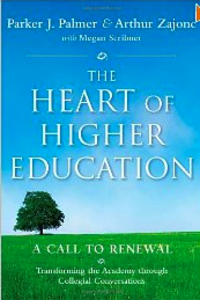 Arthur Zajonc and Parker Palmer combine forces in a new book that issues a clarion “Call to Renewal” within the corridors of higher learning. A brief review of this inspiring collection of essays shows how a more spiritual practice of teaching and learning is changing college life across the country.
Arthur Zajonc and Parker Palmer combine forces in a new book that issues a clarion “Call to Renewal” within the corridors of higher learning. A brief review of this inspiring collection of essays shows how a more spiritual practice of teaching and learning is changing college life across the country.
Marilyn Nelson, professor and poet at the University of Connecticut, recounts her experience of teaching a course on poetry and meditation to West Point cadets who were later deployed to Iraq. Amidst the chaos and suffering of the battlefield, some of them later e-mailed Professor Nelson, describing how her course was helping them to keep their composure in the face of death and violence.
One of them, a Black Hawk helicopter pilot, acknowledged that the contemplative life was in some ways the antithesis of life in the military. Nelson reports that the pilot would camouflage his practice of meditating in the barracks by sitting on his cot wearing headphones. “Everyone thought he was listening to music, which is cool. But his headphones were silent. He was being in the moment, thinking ‘here, now, here, now.'”
This anecdote is told in an appendix to a new book entitled The Heart of Education: A Call to Renewal –– Transforming the Academy through Collegial Conversations (Jossey-Bass, 2010) by Arthur Zajonc, professor of physics at Amherst College, and the best selling author Parker Palmer. These two authors document the rise of individual or small groups of professors who are introducing contemplative practice into their courses, with heart-warming effects. In an academic culture of secular materialism, these educators are inspiring their students to reach beyond their immediate motives for attending college––such as grades, employment, prestige, or simply the acquisition of information––to a deeper “aquifer of human wholeness”, as they put it, that taps the wellsprings of human spirituality and social connectedness. The results they report are profound.
With the clarity borne of strict scientific training, Zajonc makes the case for a “quantum holistic” approach to adult learning. Education, he argues, “is at its heart not the conveyance of information concerning objects, but a leading of the inquiring minds of our students through the manifold layers of experience and reason to occasions of epiphany, that is, to the exalted experience of genuine insight. This is the joy of discovery that brightens students’ faces and for which we teachers are rightly grateful.”
In this approach to learning, students, far from forsaking personal experience in favor of impersonal theory, remain grounded in experience from initial question to ultimate discovery. At the end of the day, they are evaluated on what they see, not on what they were told to see.
Central to this phenomenological approach to learning is the ability to discern the lens or instrument through which one is learning. As Zajonc puts it, “If all you have is a thermometer, then everything is a temperature.” He describes two developments in scientific research––“entanglement and emergence”––that are overthrowing the classical atomistic model of scientific explanation in which separate parts are put together to create a whole. (This view, in which the parts are used to make sense of the whole, might be called the Humpty-Dumpty approach to scientific explanation.) But, as Zajonc demonstrates, quantum physicists have come to realize that parts do not adequately account for the behavior of wholes. In growing areas of scientific research, “parts are no longer privileged” because they change as they become “entangled” with one another.
The related notion of “emergence” is also challenging the classical model of scientific reductionism. From the combination of hydrogen and oxygen, for instance, we may derive water, but the “wetness” of the water is not to be found in either of its chemical elements; rather wetness is an “emergent property” of water as a whole not reducible to any of its elementary parts.
Zajonc concludes that “through entanglement and emergence, physics offers evidence for a ontological holism that grants wholes a standing long denied them.” The whole, in other words, is finally recognized as being a reality greater than the sum of its parts.
These ideas Zajonc and Palmer now apply to the practice of higher learning, which still today can easily fall into the atomism of fragmented analysis rather than the holism of integrated discourse. The final chapters of their book call upon educators to create a more integrative––and hence more human––college experience through the cultivation of collaborative conversation. These begin not with intellectual explanation and analysis but with personal experience and story telling rich with examples of “entanglement and emergence”.
A series of appendices document cases where this approach to learning is actually being used across the traditional divide of science and humanities––or, for that matter, of scientific enquiry and religious practice––through what the authors call a “cognitively oriented spirituality” that “confounds the simplistic dichotomy of science and religion, or knowledge versus faith.” Whether in the chapel of the seminary or in the lecture halls of a military academy, courses involving disciplined contemplative meditation offer reliable yet often untrodden paths to knowledge of both self and world.
For those seeking a more integrated approach to adult learning or teaching, this inspirational volume will serve as both compass and map. It orients, it offers broad overview without prescribing any one program or course of study. However, as an example of a possible application, one appendix does include an outline to story telling developed by Marshall Ganz at Harvard’s Kennedy School of Government and practiced during the early days of Camp Obama. In this approach, participants formed collaborative research and planning groups by telling three stories: “the story of self” (how I got here), “the story of us” (how our stories connect us), and “the story of now” (what we can achieve together).
If this approach helped elect a president, think what it could do for the revitalization of learning communities!
Copies of this book are available for purchase through the Center’s Color Shop & More.
Dateline Keene, NH: Renown Film Maker Visits Waldorf Teacher Trainees
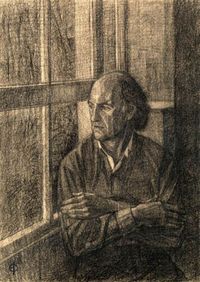
Jonathan Stedall, BBC filmmaker (portrait by Saied Dai)BBC filmmaker Jonathan Stedall filming Antioch students and their teacher, Arthur Auer, as part of documentary on Rudolf Steiner. Photo by Sean Wiley.
Arthur Auer, Director of the Waldorf Teacher Education Program at Antioch University New England, reports on a recent visit to the campus by the international filmmaker Jonathan Stedall.
Faculty and graduate students in the Waldorf Teacher Education Program at Antioch University New England were visited in October by Jonathan Stedall, the renowned BBC filmmaker from Great Britain. Mr. Stedall has been touring the United States with his film crew during the autumn to gather material for a new documentary celebrating the 150th birthday of Rudolf Steiner, born in 1861. Stedall spent a day conducting filmed interviews on the Antioch campus in Keene, NH with teachers and students in the Waldorf program.
Students were thrilled to converse with an international artist and to hear of his 150 other films including portraits of C.G. Jung, Mahatma Gandhi, the Kalahari Bushman (with Laurens van der Post), Waldorf Education, and the Camphill communities, among other subjects.

Stedall’s latest film, entitled “The Challenge of Rudolf Steiner”, combines a biographical narrative filmed in Austria, Germany, and Switzerland with archival material and interviews. Through documentary sequences, shot largely in Britain and the U.S., the film explores many strands of Steiner’s far-reaching legacy.
The final sequence will be filmed next September at the Goetheanum in Dornach, Switzerland on the occasion of an international conference celebrating Steiner’s 150th anniversary. Though aimed at television and independent film theaters, the documentary will also be made available on DVD. Details of this project can be viewed at www.rudolfsteinerfilm.com
Stedall has been a documentary filmmaker for over 40 years. His film on Camphill, entitled In Need of Special Care, won a British Film Academy Award in 1968. His lifetime of encounters with some of the most creative minds of our time formed the basis of his recently published autobiography, Where on Earth is Heaven? (Hawthorn Press, 2009).
Copies of this fascinating autobiography are available through the Center’s Color Shop & More, as will be the DVD of Stedall’s documentary, once it is released.
Dateline Toronto, ON: Convergence of Neuro-Science and Waldorf Education
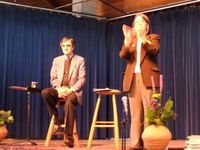 Recent research showing the influence of education on the healthy development of the brain was the focus of a conference highlighting the convergence of experimental science and Waldorf education. Here is a brief report.
Recent research showing the influence of education on the healthy development of the brain was the focus of a conference highlighting the convergence of experimental science and Waldorf education. Here is a brief report.
Douglas Gerwin, Director of the Center for Anthroposophy, and Patrice Maynard, AWSNA’s Leader of Development and Outreach, were keynote speakers in early November at a conference on “Convergence: How Science Supports the Wisdom of Waldorf Education.” The conference, held at the Toronto Waldorf School, was sponsored by the Rudolf Steiner Centre Toronto in memory of Allison Hudgins, former enrollment coordinator at the Alan Howard/Waldorf Academy school in downtown Toronto, who sparked the idea for the conference before her sudden death in March 2010.
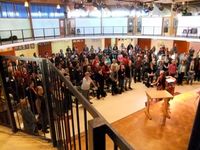 Some 250 participants attended the two-day conference, which was intended to provide Waldorf parents as well as teachers, administrators, remedial workers, day care providers, a university professor or two, and some public and charter school administrators with research that points to the facts that the brain develops in stages, does not mature until the age of 25 or so, and benefits from the curriculum provided by Steiner as the perfect enhancement/partner to brain development.
Some 250 participants attended the two-day conference, which was intended to provide Waldorf parents as well as teachers, administrators, remedial workers, day care providers, a university professor or two, and some public and charter school administrators with research that points to the facts that the brain develops in stages, does not mature until the age of 25 or so, and benefits from the curriculum provided by Steiner as the perfect enhancement/partner to brain development.
Douglas also spoke briefly during the closing session on current research into sexual development and education in our Waldorf schools. A rich array of workshops during the day included his discussion of “Agitating, Baking, Candying: Practicing the ABCs of Research” and Patrice’s “Luddite or Spot on? Understanding Waldorf’s Approach to Technology”.
Diana Hughes, who recently retired as director of the Steiner Centre, and her husband John Kettle were the masterminds of the event and did yeomen’s duty to develop and guide the conference.
Dateline New York, NY: Graduates Characterize “Life After Waldorf”
 In a panel discussion, Waldorf alumni describe what it’s like to step into the wider world of college and then a chosen profession in science or the humanities. A brief report on their observations.
In a panel discussion, Waldorf alumni describe what it’s like to step into the wider world of college and then a chosen profession in science or the humanities. A brief report on their observations.
Graduates spanning three decades of Waldorf education recently shared their experiences of “Life After Waldorf” at an evening panel discussion organized by the Rudolf Steiner School, the first Waldorf school to open in North America. The school invited three of its former students–– Alexandra Riccio ’88, Patrick Soluri ’93, and Robert Elliott ‘07––to describe the strengths and challenges of being a Waldorf graduate in the wider world. Douglas Gerwin, Director of the Center of Anthroposophy and himself a Waldorf graduate, facilitated the panel, which was held in the assembly hall of the elementary school on the evening of October 26, 2010.
The three graduates from the Rudolf Steiner School spoke movingly of their experiences as Waldorf students as well as their love for their teachers and gratitude for the gifts of their education. Robbie, the youngest on the panel, is still in college, though he has begun to work in the admissions office of Sarah Lawrence College, a popular destination for Waldorf graduates. “It was the closeness of the community that mattered most to me,” he recalled. “It was my way of being brave enough to try things that seemed at first beyond my capabilities.”
Robbie, who spent part of his junior year studying poetry and art history at Oxford University in England, will graduate this spring from Sarah Lawrence. “My education at Steiner,” he concluded, “clearly has prepared me to be successful in the things I love.”
Patrick, a freelance composer who took his seat at the panel right after leaving the first rehearsal of his new opera about to be premiered in Midtown Manhattan, remarked that he had enjoyed many of the same experiences at Steiner, even though he had graduated more than a decade earlier than Robbie. “We learned to think critically and independently and to believe in yourself – incredibly important as a composer in creating music and managing a career,” Patrick remarked. “The lasting lesson for me was I could create anything if I put my mind to it.”
Alexandra, the oldest of the three panelists, spoke of her journey through the world of conventional science to becoming a homeopathic physician. Though she was lacking some elements of empirical science, she excelled in her chosen field of study and felt her Waldorf education gave her the courage to find her own path to a profession in the healing arts.
As facilitator of the panel, Douglas related some of his own experiences as a graduate of the Waldorf School of Garden City NY, first in the field of journalism and broadcasting and later as a teacher at university and high school levels. He related how he often hears alumni from a wide range of Waldorf high schools report that they graduated from Waldorf “feeling they could do anything.” He cited a survey he recently co-authored of Waldorf graduates in which a large majority of the alumni polled state they value their Waldorf education to the point of wishing to send their own children to a Waldorf school, should that option become a possibility.
Dateline Wilton: New Line-up for Renewal Courses in 2011
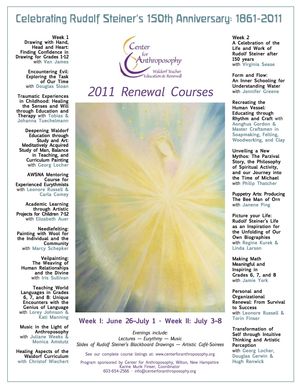 This year will mark several “firsts” for the Center’s annual Renewal Courses of five-day intensives. Karine Munk Finser, Coordinator of Renewal Courses, reports on prospects for a busy and star-studded summer.
This year will mark several “firsts” for the Center’s annual Renewal Courses of five-day intensives. Karine Munk Finser, Coordinator of Renewal Courses, reports on prospects for a busy and star-studded summer.
This summer we will dedicate our Renewal Courses to celebrating the 150th birthday of Rudolf Steiner, born in 1861. In this context, we will be hosting Virginia Sease from the leadership of the School for Spiritual Science at the Goetheanum in Dornach, Switzerland. She will offer a five-day course on “The Life and Work of Rudolf Steiner” including elements of her research on the theme of initiation and the New Mysteries.
Among other first-time appearances at our Renewal Courses:
- Douglas Sloan, professor emeritus at Teachers College Columbia University, will tackle the contemporary topic of the encounter with evil and its transformation
- Philip Thatcher, General Secretary of the Anthroposophical Society in Canada, will take up the interrelationships between the Medieval epic Parzival and Rudolf Steiner’s Philosophy of Spiritual Activity
- Jennifer Greene, director of the Water Research Center in Blue Hill, Maine, will explore the cosmic forces that flow through water
- Tobias Tuechelmann, MD, an active member in the annual International Therapists Conferences In Dornach, will examine traumatic experiences in childhood, drawing upon recent developments in neuroscience and child psychiatry. His wife Johanna Tuechelmann will offer practical exercises in movement and eurythmy
- Van James, celebrated author and high school teacher from Hawaii, will offer a drawing course based on the Waldorf curriculum, grades 1-12, as well as elements from his latest book
- Marcy Schepker will inaugurate a new workshop in needlefelting to create wall hangings for the classroom and the community
Several leading faculty members will be returning next summer with courses new to Renewal. Among them
- Christof Wiechert, outgoing leader of the Pedagogical Section at the Goethenum, will present a new course on the health-bringing aspects of the Waldorf curriculum and the teachers’ approach to education
- Aonghus Gordon, along with his team of expert craftsmen from Ruskin Mill in England, will lead a further installment of work through the crafts of clay, woodwork, felting, and soapmaking
- Janene Ping will return with a new course of marionette and shadow puppet theater, focusing upon a contemporary fairy tale, “The Bee Man or Orn”
- Georg Locher will invite teachers to work on two key texts by Rudolf Steiner, Balance in Teaching and Study of Man, with an accompanying immersion in wet-on-wet and veiling techniques in painting for grades 6-8
- Elizabeth Auer will help participants create armfuls of delightful projects arising from the Waldorf crafts curriculum for children aged 7-12
- Iris Sullivan returns this year with a course on veilpainting to school both professional artist and untrained apprentice alike.
Beyond this array of workshops, there will be evening lectures, a professional eurythmy performance to celebrate Rudolf Steiner, as well as our usual artistic soirees.
The first series of these courses run from Sunday 26 June through Friday 1 July 2011; the second week from Sunday 3 July through Friday 8 July 1011.
Consult the Center’s website (centerforanthroposophy.org) for a complete listing of courses. We encourage early registration since we expect this summer to be busy and our beautiful site on the campus of High Mowing School in Southeastern New Hampshire has a limited number of single and double rooms!
We look forward to seeing many of you this summer.
Dateline Freeport, ME: Meditation on a Moonrise over Casco Bay
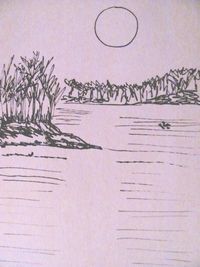 Kristin Agudelo, a participant in the Maine cluster of the Center’s Foundation Studies in Anthroposophy and the Arts, describes a potently experiential approach to studying the basic books of Rudolf Steiner.
Kristin Agudelo, a participant in the Maine cluster of the Center’s Foundation Studies in Anthroposophy and the Arts, describes a potently experiential approach to studying the basic books of Rudolf Steiner.
On a recent November Sunday, the Foundation Studies class held at the Merriconeag Waldorf School met to discuss Rudolf Steiner’s seminal work How to Know Higher Worlds. We were pleasantly surprised to find that Barbara Richardson, Coordinator of the Center’s Foundation Studies and leader of our seminar, had arranged for us to travel the fifteen minutes or so down to the Atlantic coastline and watch the moon rise over Casco Bay. The purpose for this outing was to experience one of Steiner’s spiritual exercises—specifically, watching the moon rise as a way of experiencing the inner qualities associated with decay and death.
That afternoon moonrise and sunset were only minutes apart, so we were lucky enough to see both. Standing on a chilly pier, looking out across waters teeming with animal life but devoid of other human observers, our small group watched in awed silence as the moon rose, huge and golden, above a spit of land opposite our viewing point.
It would be impossible for me to put into prose the soul-feeling that I experienced that evening. Indeed, it is difficult to put any words to it at all—which is probably why Steiner urged us each to experience it for ourselves at first-hand. However, back at the school, we were each given a little note card on which to record a quick sketch and some thoughts of the experience.
My thoughts came out in the form of Haiku-like poetry (not a form which I am accustomed to writing). Here they are—the best representations I can give to an experience that stayed with me for many days afterwards, like tea steeping in the water of my soul.
Feeling earth turning
Under my feet,
A gull cries.
Moon rises over the bay.
A twig snaps, and
Lo! The evening star.
Dateline Wilton NH: New Librarian, new additions to Cadmus Library
 Milan Daler, administrator of the Center for Anthroposophy, reports on new developments at the Cadmus Library, which recently moved into the lower level of a three-storey building owned by the Center.
Milan Daler, administrator of the Center for Anthroposophy, reports on new developments at the Cadmus Library, which recently moved into the lower level of a three-storey building owned by the Center.
The Cadmus Library, the largest lending collection of anthroposophical books and journals in New England, has a new librarian. Under the care and skill of Paul Davis, the library’s treasure-trove of books is now ordered alphabetically and in sections, as well as being electronically searchable.
Further improvements of the library, housed in the Center’s head office on Main Street in Wilton, New Hampshire, are under way, with new wood floor and a heating system to be installed before the end of the year. The library’s cozy reading room is also available for community seminars and workshops offered in conjunction with the Center’s Color Shop & More, which occupies the ground floor of the building.
Cadmus Corporation has made available a modest fund for acquisitions of newly published books and periodicals. With hopes of growing its collection, the Cadmus Library is accepting donations of books by Rudolf Steiner and by other authors related to anthroposophy. Please call (603) 654-2566 to donate.
